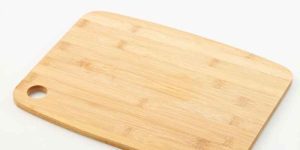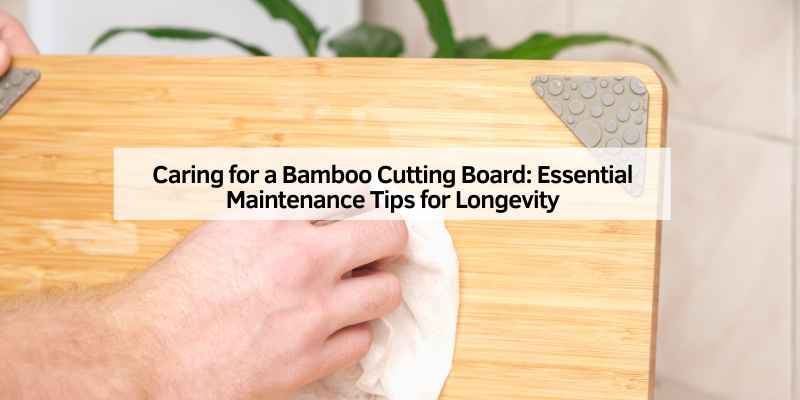To care for a bamboo cutting board, clean it with warm soapy water and dry it thoroughly after each use. Additionally, apply food-grade mineral oil to keep the bamboo moisturized and prevent cracking and splitting.
A bamboo cutting board is a popular choice for many home cooks due to its durability and sustainable nature. Not only is it a stylish addition to any kitchen, but it also offers numerous benefits over traditional cutting boards made from materials like plastic or wood.
Bamboo is a fast-growing grass that is naturally resistant to bacteria, making it a safer choice for food preparation. However, like any kitchen tool, proper care is essential to maintain its longevity and functionality. We will explore some simple yet effective ways to care for a bamboo cutting board, ensuring that it remains in pristine condition for years to come.
Cleaning Techniques
To care for a bamboo cutting board, use a mild detergent and warm water to wash it. Dry it thoroughly after washing, and avoid soaking it in water. Periodically apply mineral oil to keep the board from drying out and cracking.
Regular maintenance will ensure the longevity of your bamboo cutting board.
Bamboo cutting boards are a fantastic addition to any kitchen, known for their durability and eco-friendliness. Proper cleaning techniques are essential to ensure the longevity of your bamboo cutting board.
Handwashing With Mild Soap
To clean your bamboo cutting board, use gentle scrubbing with mild soap and warm water. Avoid harsh detergents as they can damage the bamboo surface.
Avoiding Submerging In Water
Do not soak your bamboo cutting board in water or put it in the dishwasher. Excessive moisture can cause the board to warp or crack. Clean it promptly after use and dry it thoroughly.
Remember to sanitize your cutting board regularly to prevent bacteria buildup and extend its lifespan.
Drying Methods
To care for a bamboo cutting board, it is important to use proper drying methods. After cleaning, allow the board to air dry completely before storing to prevent moisture buildup and warping.
Air-drying
Air-drying is one of the simplest and most effective ways to dry your bamboo cutting board. After washing the board with warm soapy water, pat it dry with a clean towel to remove excess moisture. Then, set the cutting board upright in a well-ventilated area.
Ensure that both sides of the bamboo cutting board are exposed to the air. This will help accelerate the drying process and prevent moisture from being trapped in the wood, which can lead to mold and bacterial growth.
It’s important to note that air-drying may take some time, especially for thicker or denser bamboo cutting boards. Be patient and allow sufficient drying time to ensure that your board is completely dry before using or storing it.
Avoiding Direct Sunlight
While sunlight can have beneficial effects on many things, it is not recommended for drying bamboo cutting boards. Direct sunlight can cause the wood to dry out too quickly, leading to cracks and warping.
Excessive exposure to sunlight can also cause the natural oils and moisture in the bamboo to evaporate, making the board more susceptible to damage and less durable over time. To protect your cutting board, always avoid placing it in direct sunlight while drying.
Instead, find a shaded spot or use a well-ventilated area indoors to air-dry the bamboo cutting board after washing.
| Drying Method | Advantages | Disadvantages |
|---|---|---|
| Air-drying | Simple and effective | Takes time |
| Avoiding direct sunlight | Prevents cracking and warping | May require indoor drying space |
Oil Treatment
To care for a bamboo cutting board, consider using an oil treatment to maintain its quality. Apply a thin layer of mineral oil over the surface and let it soak in to prevent cracking and splitting. Repeat this process regularly to keep the board in top condition.
To maintain the quality and longevity of your bamboo cutting board, engaging in an oil treatment is essential. This process involves applying oil to the board to keep it hydrated, preventing cracking and damage over time. Proper oil treatment can also help avoid the absorption of odors and stains, keeping the cutting board in top condition.
Using Food-grade Mineral Oil
Using food-grade mineral oil is crucial for maintaining the purity of your bamboo cutting board. This type of oil ensures that no harmful chemicals or toxins come into contact with the food you prepare. When selecting mineral oil, be sure to choose a high-quality, food-safe product specifically designed for use on cutting boards.
Frequency Of Oil Application
The frequency of oil application depends on the usage of the cutting board. For heavily used boards, it is recommended to apply oil once a month, while for less frequently used boards, oiling every three to six months may be sufficient. Regularly inspect the cutting board for signs of dryness or roughness, as these indicate the need for reapplication of oil.
Regular oil treatment of your bamboo cutting board is vital for its longevity and hygienic maintenance. Using food-grade mineral oil and adhering to a suitable application frequency is essential to ensure the board’s durability and performance. Incorporating these practices will allow you to enjoy a pristine cutting surface for years to come.
Removing Stains And Odors
When it comes to maintaining a bamboo cutting board, removing stains and odors is a crucial step to ensure its longevity and cleanliness. Here are some effective methods to help you tackle this issue and keep your bamboo cutting board fresh and odor-free.
Lemon And Salt Scrub
The combination of lemon and salt offers a natural and non-toxic solution for eliminating stains and odors from your bamboo cutting board. Follow these steps to create a simple yet powerful solution:
- Cut a lemon in half and sprinkle a generous amount of coarse sea salt over the surface of the cutting board.
- Use the lemon as a scrubber, gently rubbing it into the stains and odorous areas. The acidity of the lemon, combined with the abrasiveness of the salt, helps to lift stains and neutralize odors effectively.
- Allow the mixture to sit on the cutting board for a few minutes before thoroughly rinsing it with warm water and allowing it to dry completely.
Baking Soda Paste
Baking soda is another potent natural ingredient that can assist in removing stains and odors from your cutting board. Here’s how to create a baking soda paste for this purpose:
- Mix a small amount of baking soda with water to form a thick paste.
- Spread the paste over the stained and odorous areas of the cutting board, ensuring an even application.
- Allow the paste to sit for at least 15-20 minutes to penetrate the stains and absorb the odors.
- Scrub the board with a gentle brush or sponge to work the paste into the surface, then rinse thoroughly with warm water and allow it to dry completely.
Preventing Damage
Caring for your bamboo cutting board is essential to ensure its longevity and maintain its quality. By taking preventative measures, you can keep your cutting board looking great and functioning properly for years to come. In this section, we will explore two important steps in preventing damage to your bamboo cutting board: using cutting mats and avoiding harsh cleaners.
Using Cutting Mats
Using cutting mats is a simple and effective way to protect your bamboo cutting board from scratches and stains. These mats act as a barrier between your knives and the cutting board’s surface, reducing the potential for damage. Place a cutting mat on top of the bamboo cutting board before you start chopping, dicing, or slicing your ingredients. The mat will also help to prevent cross-contamination by creating a separate area for different types of food.
Avoiding Harsh Cleaners
When it comes to cleaning your bamboo cutting board, it is essential to steer clear of harsh cleaners that can damage the natural fibers of the wood. Instead, opt for gentle cleaning solutions that are safe for food surfaces. A mixture of warm water and mild dish soap is usually sufficient to clean your cutting board thoroughly. After washing, make sure to dry your bamboo cutting board completely to prevent any moisture from seeping into the wood, which can lead to warping or cracking.
If your bamboo cutting board requires a deeper clean or has stubborn stains or odors, you can create a natural cleaning paste by mixing baking soda and water. Apply this paste to the affected areas, scrub gently, and rinse with warm water. This gentle yet effective method will keep your cutting board clean and well-maintained without causing any damage.
By following these preventive measures of using cutting mats and avoiding harsh cleaners, you can ensure the longevity and pristine condition of your bamboo cutting board. These simple steps will allow you to enjoy the benefits of a durable cutting surface while maintaining excellent hygiene in your kitchen.
Storage Tips
To care for a bamboo cutting board, ensure to regularly oil it with food-safe mineral oil to maintain its durability and prevent cracking. Keep it dry between uses and never soak it in water to prolong its lifespan. Store it upright to allow proper air circulation.
Properly Dry Before Storing
To prevent mold issues, ensure your bamboo cutting board is completely dry before putting it away.
Avoiding Humid Areas
Store your bamboo cutting board in a cool, dry place away from humidity and direct sunlight.
Regular Inspections
Regular inspections are essential for maintaining a bamboo cutting board’s longevity and hygiene. By routinely examining for cracks, discoloration, and odors, you can ensure that your cutting board remains in optimal condition.
Regularly inspecting your bamboo cutting board is essential for maintaining its quality and longevity.
Checking For Splinters
Check the surface for any small splinters that may have formed during use.
Inspecting For Cracks
Look closely for any visible cracks that could compromise the board’s durability.
Inspect regularly to catch any issues early and ensure your bamboo cutting board remains in top condition.

Frequently Asked Questions Of Caring For A Bamboo Cutting Board
How Can I Clean My Bamboo Cutting Board Properly?
To clean your bamboo cutting board, use warm soapy water and a soft sponge to scrub the surface. Rinse thoroughly and let it air dry. Avoid soaking the board or using harsh chemicals that can damage the bamboo.
Can I Use Bleach To Disinfect My Bamboo Cutting Board?
It’s not recommended to use bleach on a bamboo cutting board as it can weaken the material and leave harmful residues that can contaminate food. Instead, use a mixture of water and white vinegar to disinfect the board effectively.
How Do I Remove Stains And Odors From My Bamboo Cutting Board?
To remove stains and odors from a bamboo cutting board, apply a paste made of baking soda and water on the affected areas. Let it sit for a few minutes, then scrub with a damp cloth. Rinse thoroughly and air dry.
Is It Safe To Use Oil On My Bamboo Cutting Board?
Using food-grade mineral oil or bamboo cutting board oil is safe and recommended to maintain the bamboo’s integrity and prevent it from drying out or cracking. Apply a thin layer of oil, let it soak for a few hours, then wipe off the excess.
Conclusion
To keep your bamboo cutting board in top condition, remember to follow these simple care tips. Regularly clean it with warm, soapy water and pat it dry immediately. Avoid excessive moisture, harsh chemicals, and direct sunlight. Periodically oil the board with mineral oil to prevent drying and cracking.
By giving your bamboo cutting board the proper care, it will serve you well for years to come. Take care of it, and it will take care of you.


